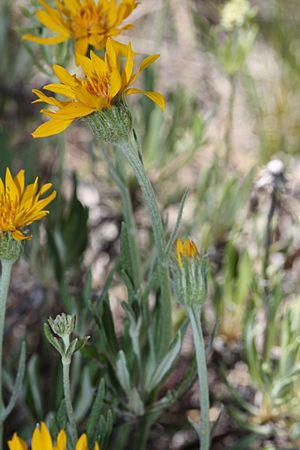Woolly mock goldenweed facts for kids
Quick facts for kids Woolly mock goldenweed |
|
|---|---|
 |
|
| Scientific classification | |
| Kingdom: | |
| (unranked): | |
| (unranked): | |
| (unranked): | |
| Order: | |
| Family: | |
| Tribe: |
Astereae
|
| Genus: |
Stenotus
|
| Species: |
S. lanuginosus
|
| Binomial name | |
| Stenotus lanuginosus (A.Gray) Greene
|
|
| Synonyms | |
|
Haplopappus lanuginosus |
|
Stenotus lanuginosus is a type of flowering plant. It is part of the aster family, which includes sunflowers and daisies. People often call it the woolly mock goldenweed or woolly stenotus.
Where It Grows
This plant is found only in the western United States. This means it is endemic to that area. You can mostly find it in the Great Basin region. This includes parts of the inland Pacific Northwest, northeastern California, and northern Nevada.
It likes to grow in places that are cold and dry. You might see it in areas with sagebrush plateaus. It also grows on high mountain slopes. These areas are often in subalpine and alpine climates. This means it grows where it is very cold, even high up in the mountains.
What It Looks Like
Stenotus lanuginosus is a perennial herb. This means it is a plant that lives for more than two years. It usually grows in a tight, bushy clump. It has a fibrous root system, which means its roots spread out like a network.
Its leaves can be long and thin or wider and shaped like a spear. They can grow up to 10 centimeters (about 4 inches) long. The leaves are covered in soft, white, woolly fibers. They also often feel a bit sticky because they have small glands.
The plant produces a single flower head. This is a cluster of many small flowers that look like one big flower. The flower head has green phyllaries, which are like small leaves around the base. These phyllaries are also woolly or hairy.
Inside the flower head, you will find yellow disc florets. These are the tiny flowers in the center. Around them are several yellow ray florets. These are the petal-like parts, and each one is about a centimeter long.

